An Armory of Famous Writers
* Johann-Wolfgang von Goethe (1749-1832; Saxony, ennobled by the Emperor 1782):
Arms: azure, a star and a border or.
[Rietstap]
 * Friedrich von Schiller (1759-1805, knighted Sep. 7, 1802):
Arms: per fess, Or a unicorn issuant argent, Azure a fess or. Crest: a
crown of laurels vert.
[Rietstap]
* Friedrich von Schiller (1759-1805, knighted Sep. 7, 1802):
Arms: per fess, Or a unicorn issuant argent, Azure a fess or. Crest: a
crown of laurels vert.
[Rietstap]
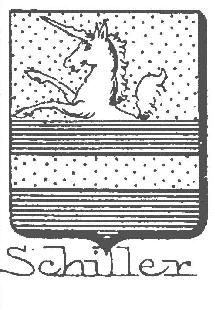 * Arthur Schopenhauer (1788-1860): Vert a bend between two stars of six points
all argent.
[Klaus K]
* Pierre Corneille (1606-84, an. 1637): Azure on a fess or between three mullets
argent, three lions' heads gules.
[Rietstap]
* Arthur Schopenhauer (1788-1860): Vert a bend between two stars of six points
all argent.
[Klaus K]
* Pierre Corneille (1606-84, an. 1637): Azure on a fess or between three mullets
argent, three lions' heads gules.
[Rietstap]
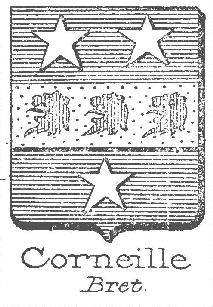 * Jean de La Fontaine (1621-95): Or three frets sable.
[D'Hozier Soissons, registered to his widow.]
* Jean Racine (1639-99): azure a swan argent beaked and armed sable.
[Rietstap]
* Jean de La Fontaine (1621-95): Or three frets sable.
[D'Hozier Soissons, registered to his widow.]
* Jean Racine (1639-99): azure a swan argent beaked and armed sable.
[Rietstap]
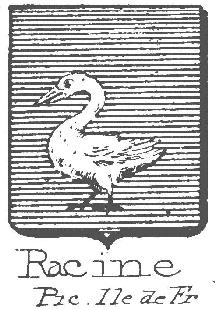 * Bossuet: Azure three wheels or.
[ANF 1845]
* Brantôme: Or two griffin's paws in pale gules armed azure.
[ANF 1845]
* Buffon: Argent on a bend gules a mullet or.
[ANF 1845]
* Fénelon: Or three bends vert.
[ANF 1845]
* Florian: Or an eagle sable on a chief azure a sun or to which the eagle looks.
[ANF 1845]
* Malherbe: ermine six roses gules.
[ANF 1845]
* Scarron: Azure a bend embattled counter embattled or.
[ANF 1845]
* Vaugelas: Argent a chevron azure between three Moor's heads sable wreathed of the
first.
[ANF 1845]
* Charles Perrault (1628-1703): Or on an escutcheon azure an escutcheon argent.
[ANF 1884]
* François Quinault (1635-88): azure a chevron or between three
"soucis" slipped or.
[ANF 1884]
* Furetière: Gules three cucumbers argent.
[ANF 1884]
* Montesquieu (Charles-Louis de Secondat, baron de La Brède et, 1689-1755): Azure
2 escallops or and a crescent argent.
[any French 200F bill]
* Bossuet: Azure three wheels or.
[ANF 1845]
* Brantôme: Or two griffin's paws in pale gules armed azure.
[ANF 1845]
* Buffon: Argent on a bend gules a mullet or.
[ANF 1845]
* Fénelon: Or three bends vert.
[ANF 1845]
* Florian: Or an eagle sable on a chief azure a sun or to which the eagle looks.
[ANF 1845]
* Malherbe: ermine six roses gules.
[ANF 1845]
* Scarron: Azure a bend embattled counter embattled or.
[ANF 1845]
* Vaugelas: Argent a chevron azure between three Moor's heads sable wreathed of the
first.
[ANF 1845]
* Charles Perrault (1628-1703): Or on an escutcheon azure an escutcheon argent.
[ANF 1884]
* François Quinault (1635-88): azure a chevron or between three
"soucis" slipped or.
[ANF 1884]
* Furetière: Gules three cucumbers argent.
[ANF 1884]
* Montesquieu (Charles-Louis de Secondat, baron de La Brède et, 1689-1755): Azure
2 escallops or and a crescent argent.
[any French 200F bill]
 * Voltaire (Arouet, 1694-1778): azure three flames or.
[D'Hozier Paris, Rietstap]
* Claude-Adrien Helvetius (1715-71), philosopher: Azure two wings or
beneath an eye argent.
[D'Hozier Paris 3:585]
* Voltaire (Arouet, 1694-1778): azure three flames or.
[D'Hozier Paris, Rietstap]
* Claude-Adrien Helvetius (1715-71), philosopher: Azure two wings or
beneath an eye argent.
[D'Hozier Paris 3:585]
* Pierre Choderlos de Laclos (1741-1803): Azure two arrows per saltire or shafted argent
between four flames of the second, on a chief gules 9 billets of the second 5 and 4.
[Jougla de Morenas. Author of Les Liaisons Dangereuses.]
* Victor Hugo (1802-85): Azure, on a chief argent two martlets sable.
[Rietstap.]

* Charles-Augustin de Sainte-Beuve (1804-69): Azure three rings argent.
[D'Hozier Paris 3:593]
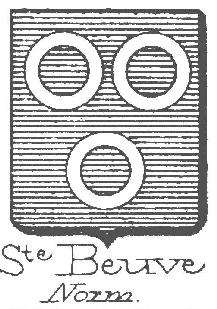 * Alfred de Musset (1810-57): Azure a sparrow-hawk (épervier) or,
with hood, leash and perch gules.
[Rietstap]
* Miguel de Cervantes Saavedra (1547-1616): within a bordure gules
charged with saltires couped or, azure, two stags or. Helm, mantling
and feathers, but no crest.
[Klaus K]
* Dante Alighieri (1265-1321): per pale or and sable a fess argent.
(Moderns arms of the family: azure a wing argent).
[Pompeo Litta, Famiglie Celebri Italiane]
* Alfred de Musset (1810-57): Azure a sparrow-hawk (épervier) or,
with hood, leash and perch gules.
[Rietstap]
* Miguel de Cervantes Saavedra (1547-1616): within a bordure gules
charged with saltires couped or, azure, two stags or. Helm, mantling
and feathers, but no crest.
[Klaus K]
* Dante Alighieri (1265-1321): per pale or and sable a fess argent.
(Moderns arms of the family: azure a wing argent).
[Pompeo Litta, Famiglie Celebri Italiane]
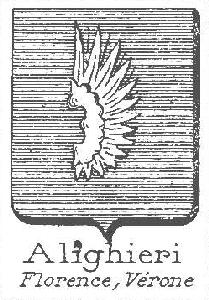 * Niccolo Machiavelli (1469-1527): Argent, a cross angle with four nails azure.
[Pompeo Litta, Famiglie Celebri Italiane]
* Niccolo Machiavelli (1469-1527): Argent, a cross angle with four nails azure.
[Pompeo Litta, Famiglie Celebri Italiane]
 * Lodovico Ariosto (1474-1533): per fess, or an eagle displayed sabel crowned
or, and pally of 6 azure and argent.
[Pompeo Litta, Famiglie Celebri Italiane]
* Francesco Guicciardini (1483-1540): Azure three bugle-horns argent
stringed gules.
[Pompeo Litta, Famiglie Celebri Italiane]
* Lodovico Ariosto (1474-1533): per fess, or an eagle displayed sabel crowned
or, and pally of 6 azure and argent.
[Pompeo Litta, Famiglie Celebri Italiane]
* Francesco Guicciardini (1483-1540): Azure three bugle-horns argent
stringed gules.
[Pompeo Litta, Famiglie Celebri Italiane]
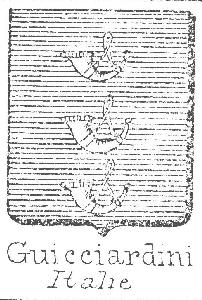 * Giacomo Casanova (1725-98): alleged son of Gaetano C., an actor, and Giovanna
Farussi, daughter of a shoemaker, and an actress/dancer herself.
Casanova was considered by many, including himself, to be the natural
son of Michele Grimani, a Venitian patrician who owned the theater
S. Anselmo where C.'s parents worked and lived. Grimani had a coat of arms:
pally of eight, Argent and Gules.
Casanova took the name of chevalier de Seingalt: chevalier because he was
made knight of the Golden Spur, a rather easy-to-obtain Papal order, in
1760. Seingalt is a pseudonym of unknown origin.
* Geoffrey Chaucer, Esq (ca. 1342-1400):
per pale argent and gules, a bend counter changed. Crest: a tortoise proper.
[Rietstap]
* Giacomo Casanova (1725-98): alleged son of Gaetano C., an actor, and Giovanna
Farussi, daughter of a shoemaker, and an actress/dancer herself.
Casanova was considered by many, including himself, to be the natural
son of Michele Grimani, a Venitian patrician who owned the theater
S. Anselmo where C.'s parents worked and lived. Grimani had a coat of arms:
pally of eight, Argent and Gules.
Casanova took the name of chevalier de Seingalt: chevalier because he was
made knight of the Golden Spur, a rather easy-to-obtain Papal order, in
1760. Seingalt is a pseudonym of unknown origin.
* Geoffrey Chaucer, Esq (ca. 1342-1400):
per pale argent and gules, a bend counter changed. Crest: a tortoise proper.
[Rietstap]
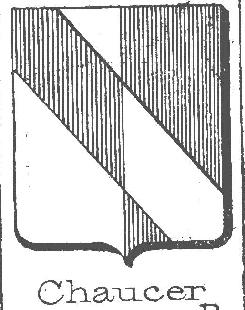 * Sir Thomas Malory (fl. 1470): Quarterly: 1 & 4 Ermine, a chevron
gules and a border engrailed sable (for Revel); 2 & 3 Or, three lions
passant sable (for Malory).
[A. Wagner]
* Sir Thomas More (1478-1535): Quarterly, 1 and 4. argent, a chevron engrailed between
three moorcocks armed, crested and jelloped gules, all sable; 2 and 3.
argent, on a chevron between three unicorn's heads couped sable, three
bezants or.
[Rietstap] (see a
bibliography)
* Sir Thomas Malory (fl. 1470): Quarterly: 1 & 4 Ermine, a chevron
gules and a border engrailed sable (for Revel); 2 & 3 Or, three lions
passant sable (for Malory).
[A. Wagner]
* Sir Thomas More (1478-1535): Quarterly, 1 and 4. argent, a chevron engrailed between
three moorcocks armed, crested and jelloped gules, all sable; 2 and 3.
argent, on a chevron between three unicorn's heads couped sable, three
bezants or.
[Rietstap] (see a
bibliography)
 * Sir Philip Sidney (1554-86): Or, a pheon azure.
* Sir Philip Sidney (1554-86): Or, a pheon azure.
 * William Shakespeare (1564-1623): Or, on a bend sable a spear of
the first, pointed argent. Crest: a falcon rising argent, holding in
its dexter claw a spear in pale or. Motto: Non sans droict.
* William Shakespeare (1564-1623): Or, on a bend sable a spear of
the first, pointed argent. Crest: a falcon rising argent, holding in
its dexter claw a spear in pale or. Motto: Non sans droict.
 * Ben Jonson
(1572-1637): Argent, a saltire Sable, on a chief Gules, three cushions Or.
* John Milton (1608-74): Argent, a double-headed eagle displayed gules,
beaked and legged azure.
[A. Wagner. Rietstap]
* Ben Jonson
(1572-1637): Argent, a saltire Sable, on a chief Gules, three cushions Or.
* John Milton (1608-74): Argent, a double-headed eagle displayed gules,
beaked and legged azure.
[A. Wagner. Rietstap]
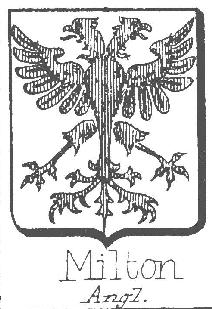 * Dryden (1631-1700): Azure, a lion rampant and in chief a sphere between
two estoiles or. For cadency, a mullet.
[A. Wagner]
* Dryden (1631-1700): Azure, a lion rampant and in chief a sphere between
two estoiles or. For cadency, a mullet.
[A. Wagner]
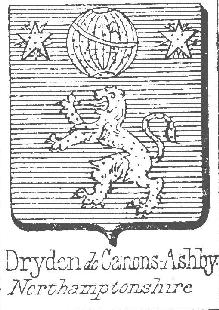 * Samuel Pepys (1633-1703): Sable, on a bend or between two horses' heads
erased argent three fleurs de lys of the field. For cadency, a crescent.
[A. Wagner]
* Samuel Pepys (1633-1703): Sable, on a bend or between two horses' heads
erased argent three fleurs de lys of the field. For cadency, a crescent.
[A. Wagner]
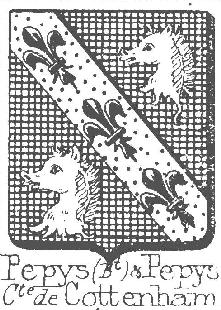 * Jonathan Swift (1667-1745): Sable, an anchor in pale or, stock azure,
the stem entwined by a dolphin descending argent.
[A. Wagner]
* Jonathan Swift (1667-1745): Sable, an anchor in pale or, stock azure,
the stem entwined by a dolphin descending argent.
[A. Wagner]
 * Henry Fielding (1707-54): Argent, on a fess azure three lozenges or. For
cadency, a mullet within an annulet.
[A. Wagner]
* David Hume (1711-76): vert a lion argent on a bordure gules nine torteaux
[on his bookplate on a copy of Shaftesbury's Characteristicks, in the National Library
of Scotland, reproduced in The David Hume Library by Norton and Nortn (1996).
Motto: true to the end.]
* Laurence Sterne (1713-68): or a chevron between three crosslets flory sable.
Crest: a starling.
[In his Sentimental Journey (1768; vol. 2, chap. 5), Sterne tells the story of
a starling he found in an inn of Paris, that had been taught to say "I can't get out!".
"from that time to this, I have borne this poor starling as the crest to my arms. -- Thus:
* Henry Fielding (1707-54): Argent, on a fess azure three lozenges or. For
cadency, a mullet within an annulet.
[A. Wagner]
* David Hume (1711-76): vert a lion argent on a bordure gules nine torteaux
[on his bookplate on a copy of Shaftesbury's Characteristicks, in the National Library
of Scotland, reproduced in The David Hume Library by Norton and Nortn (1996).
Motto: true to the end.]
* Laurence Sterne (1713-68): or a chevron between three crosslets flory sable.
Crest: a starling.
[In his Sentimental Journey (1768; vol. 2, chap. 5), Sterne tells the story of
a starling he found in an inn of Paris, that had been taught to say "I can't get out!".
"from that time to this, I have borne this poor starling as the crest to my arms. -- Thus:
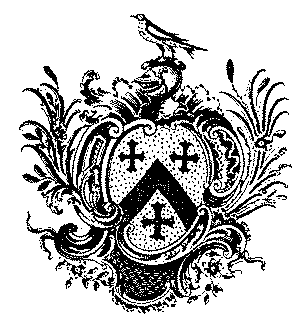 And let the heralds officers twist his neck about if they dare."]
* Edward Gibbon (1737-94): (Probably) Sable, a lion rampant argent between
three escallops or.
[A. Wagner]
* Sir Walter Scott (1771-1832, Baronet Apr. 22, 1820):
Arms: Quarterly: 1 and 4, Or two five-pointed stars in chief and a crescent
in base within an orle azure; 2 and 3 Or, on a bend azure three mascles of
the first, in senester chief an oval buckle of the second.
And let the heralds officers twist his neck about if they dare."]
* Edward Gibbon (1737-94): (Probably) Sable, a lion rampant argent between
three escallops or.
[A. Wagner]
* Sir Walter Scott (1771-1832, Baronet Apr. 22, 1820):
Arms: Quarterly: 1 and 4, Or two five-pointed stars in chief and a crescent
in base within an orle azure; 2 and 3 Or, on a bend azure three mascles of
the first, in senester chief an oval buckle of the second.
 * Samuel Taylor Coleridge (1772-1834): Argent, on a mount in base vert an
otter statant proper, on a chief gules a dove close proper between two crosses
patee fitchee or. For cadency, an annulet.
[A. Wagner]
* Samuel Taylor Coleridge (1772-1834): Argent, on a mount in base vert an
otter statant proper, on a chief gules a dove close proper between two crosses
patee fitchee or. For cadency, an annulet.
[A. Wagner]
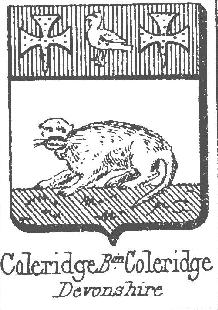
* Jane Austen (1775-1817): Or a chevron gules between three lions' gambs erased.
[from a bookplate taken from Jane Austen's Letters to her Sister Cassandra and
Others edited by R. W. Chapman (1952, p. 523), used by a paternal cousin.
These arms were also used, e.g., by her brother Edward Knight as a quartering.
See Henry Churchyard's Jane Austen Info Page.
A. Wagner has three bezants on the chevron, only on the basis of a 16th c.
Visitation.]
* Lord Byron, George Gordon (1788-1824): argent, three bendlets enhanced gules.
Crest: a mermaid holding a comb and a mirror proper. Supporters:
two horses argent. Motto: CREDE BYRON
[Rietstap]
 * Percy Bysshe Shelley (1792-1822): Sable, a fess engrailed between three
whelk shells or. For cadency, a label.
[A. Wagner]
* Percy Bysshe Shelley (1792-1822): Sable, a fess engrailed between three
whelk shells or. For cadency, a label.
[A. Wagner]
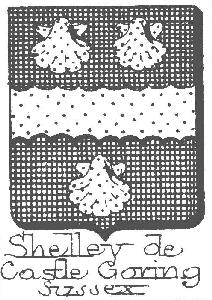 * Lord Macaulay (William Babbington Macaulay, 1800-59, baron 1857): Gules,
two arrows saltirewise points downward argent surmounted by as many barrulets
compony or and azure between two buckles in pale of the third, all within a
bordure engrailed also of the third. Crest: a spurred boot. Motto: Dulce
periculum.
[A. Wagner, Rietstap]
* Lord Macaulay (William Babbington Macaulay, 1800-59, baron 1857): Gules,
two arrows saltirewise points downward argent surmounted by as many barrulets
compony or and azure between two buckles in pale of the third, all within a
bordure engrailed also of the third. Crest: a spurred boot. Motto: Dulce
periculum.
[A. Wagner, Rietstap]
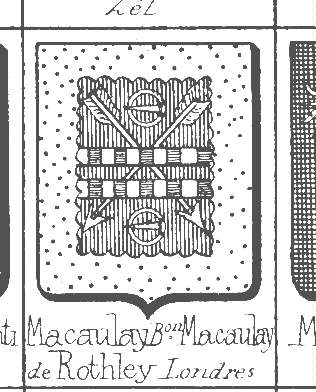 * Alfred Lord Tennyson (1809-92): Gules, on a bend nebuly or between three
leopards' faces jessant-de-lis of the last, a wreath of laurel proper.
[A. Wagner]
* Alfred Lord Tennyson (1809-92): Gules, on a bend nebuly or between three
leopards' faces jessant-de-lis of the last, a wreath of laurel proper.
[A. Wagner]
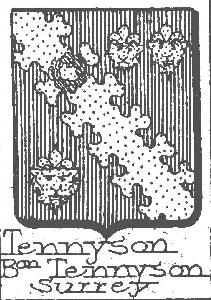 * William Makepeace Thackeray (1811-63): Vert, two garbs or, in base an arrow
argent, on a chief purpure a cherub's head proper between two estoiles of the
third. For cadency, a mullet.
[A. Wagner]
* Anthony Trollope (1815-82): Vert three stags argent attired or within a
bordure of the second.
[Burke's; Anthony Trollope was the second great-grandson of
Sir Thomas Trollope, 4th baronet; eventually his line succeeded to the
title and his descendant is the 16th baronet.]
* John Ruskin (1819-1900): Sable on a chevron between six spearheads argent three crosses
crosslets tichy gules.
[A. Wagner]
* William Makepeace Thackeray (1811-63): Vert, two garbs or, in base an arrow
argent, on a chief purpure a cherub's head proper between two estoiles of the
third. For cadency, a mullet.
[A. Wagner]
* Anthony Trollope (1815-82): Vert three stags argent attired or within a
bordure of the second.
[Burke's; Anthony Trollope was the second great-grandson of
Sir Thomas Trollope, 4th baronet; eventually his line succeeded to the
title and his descendant is the 16th baronet.]
* John Ruskin (1819-1900): Sable on a chevron between six spearheads argent three crosses
crosslets tichy gules.
[A. Wagner]
* Oscar Wilde (1854-1900): ???.
[2nd son of Sir William Ralph Wills Wilde (1815-76), prominent eye surgeon. Did he bear arms?]
* Sir Arthur Conan Doyle:
quarterly Doyle, Foley, Pack, Percy of Ballintemple. (See
an illustration.
[Arms granted in 1951 to his second Adrian in 1951 (Sunday
Telegraph, 6 Sep 1992).]
* Friedrich August Hayek (1899-1992):
Von S. und B. schrgr. get., oben eine r. funfblaettige g. besamte Blume, unten
ein schrgr. s. Anker; auf gekr. H. mit b.-s. Decken 3 Straussenfedern b.-s.-b.,
deren mittle zu oberst mit d. beschriebenen Blume bel. ist.
[arms granted 11 Aug 1789 upon ennobmement of Josef Hayek. Wiener
genealogisches Taschenbuch, 1927-28, p. 119.]


















 * Ben Jonson
(1572-1637): Argent, a saltire Sable, on a chief Gules, three cushions Or.
* John Milton (1608-74): Argent, a double-headed eagle displayed gules,
beaked and legged azure.
[A. Wagner. Rietstap]
* Ben Jonson
(1572-1637): Argent, a saltire Sable, on a chief Gules, three cushions Or.
* John Milton (1608-74): Argent, a double-headed eagle displayed gules,
beaked and legged azure.
[A. Wagner. Rietstap]










